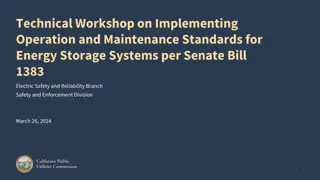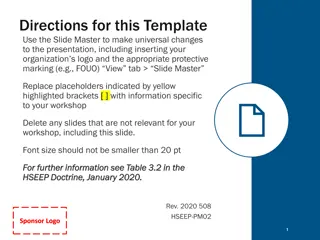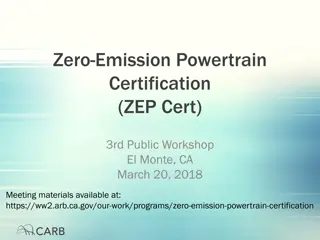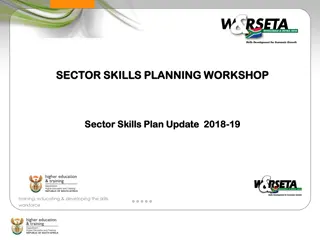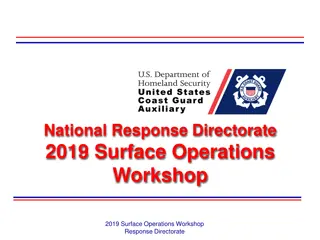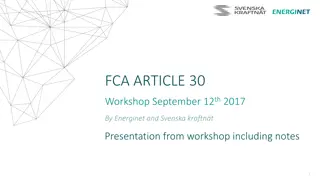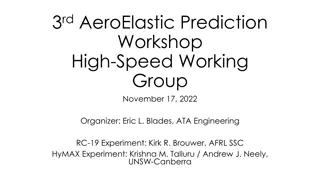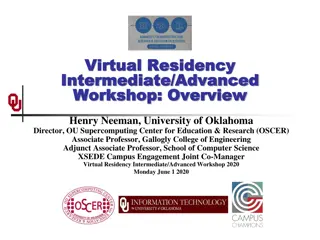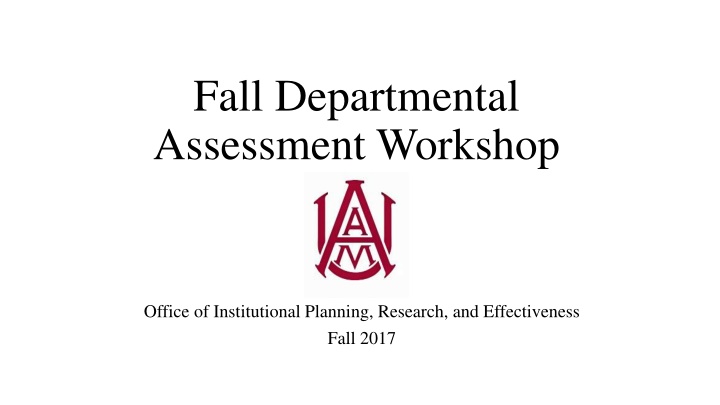
Departmental Assessment Workshop and Student Learning Outcomes Analysis
Explore the steps involved in departmental assessment workshops and the analysis of student learning outcomes. Learn how to develop program purpose statements, student learning outcomes, assessment measures, and targets. Understand the importance of using multiple assessment measures to evaluate student competence effectively. Discover direct measures of student learning and how they contribute to program improvement and student success.
Download Presentation

Please find below an Image/Link to download the presentation.
The content on the website is provided AS IS for your information and personal use only. It may not be sold, licensed, or shared on other websites without obtaining consent from the author. If you encounter any issues during the download, it is possible that the publisher has removed the file from their server.
You are allowed to download the files provided on this website for personal or commercial use, subject to the condition that they are used lawfully. All files are the property of their respective owners.
The content on the website is provided AS IS for your information and personal use only. It may not be sold, licensed, or shared on other websites without obtaining consent from the author.
E N D
Presentation Transcript
Fall Departmental Assessment Workshop Office of Institutional Planning, Research, and Effectiveness Fall 2017
Assessment Steps 1. Develop Program Purpose statement 2. Develop Three Student Learning Outcomes 3. Develop Two appropriate Assessment Measures per Outcome 4. Develop desired Assessment Targets 5. Analyze Assessment Results 6. Develop and implement, Use of Results Office of Institutional Planning, Research, and Effectiveness 2
Student Learning Outcomes Student learning outcomes are general statements of what you expect students to know, think, or be able to do when they complete the program What are the outcomes of your program/unit in terms of student learning? Is there any change in terms of program outcomes compared to the previous year? If so, what triggered the change? How has it been implemented? Examples Specific and relatively EASY to measure 1. will be able to explain how exercise affects stress. 2. will be able to identify the most appropriate resource that is pertinent to their college concern. 3. will be able to assist classmates in resolving conflicts by helping them negotiate agreements. Office of Institutional Planning, Research, and Effectiveness 3
Assessment Measures No single test score can be considered a definitive measure of a student s competence. Multiple measures enhance the validity and fairness of the inferences drawn by giving students various ways and opportunities to demonstrate their competence (National Research Council, 2001). Office of Institutional Planning, Research, and Effectiveness 4
Assessment Measures Direct Measures of Student Learning Scores and pass rates on standardized tests Writing samples Score gains Locally designed quizzes, tests, and inventories Portfolio artifacts Capstone projects Case studies Team/group projects and presentations Oral examination Internships, clinical experiences, practica, student teaching, or other professional/content-related experiences Service-learning projects or experiences Authentic and performance-based projects or experiences Graduates skills in the workplace rated by employers Online course asynchronous discussions Office of Institutional Planning, Research, and Effectiveness 5
Assessment Measures Indirect Measures of Student Learning Course grades Grades assigned to student work in one particular course Comparison between admission and graduation rates Number or rate of graduating students pursuing their education at the next level Reputation of graduate or post-graduate programs accepting graduating students Employment or placement rates of graduating students into appropriate career positions Course evaluation items related to the overall course or curriculum quality Number or rate of students involved in faculty research, collaborative publications and/or presentations, service learning, or extension of learning in the larger community Surveys, questionnaires, open-ended self-reports, focus-group or individual interviews Quantitative data Honors, awards, scholarships, and other forms of public recognition earned by students and alumni [Adapted from Maki, P.L. (2004). Assessing for learning: building a sustainable commitment across the institution. Sterling, VA: AAHE; and Suskie, L. (2004). Assessing student learning: A common sense guide. San Francisco, CA: Anker Publishing Company, Inc.] Office of Institutional Planning, Research, and Effectiveness 6
Assessment Targets Examples 1 100% of students assessed will score at least 80% or higher on section pertaining to critical thinking. 2 80% of students assessed will score at least 25 out of 50 points on oral communication rubric 3 75% of students assessed will receive a rank of satisfactory or higher on their capstone presentation Office of Institutional Planning, Research, and Effectiveness 7
Disaggregation of Data for Online & Off-Site Learners The following text was extracted from page 5 of the Principles of Accreditation: The Commission on Colleges bases its accreditation of degree-granting higher education institutions and entities on requirements in the Principles of Accreditation: Foundations for Quality Enhancement. These requirements apply to all institutional programs and services, wherever located or however delivered. This includes programs offered through distance and correspondence education, off-campus sites, and branch campuses. Office of Institutional Planning, Research, and Effectiveness 8
Assessment Results Who was involved in your program/unit review of the findings from your analysis of student learning assessment data? When did the review process take place? If the case, have the reviewers recommendations from the previous year report been addressed? Office of Institutional Planning, Research, and Effectiveness 9
Use of Results Based on your review of findings, what changes have been made to the curriculum, OR services, OR goals, OR student learning outcomes (choose all that apply) in your program/unit? Also, have any of these changes led to modifications in the process of collecting and/or reviewing student learning assessment data? If the case, have the recommendations from the previous year report been addressed? Office of Institutional Planning, Research, and Effectiveness 10
Disaggregation of Data for Online & Off-Site Learners 2015 2016 Outcomes Reports Modify 2016 2017 Outcomes Reports Complete 2017 2018 Outcomes Plans Complete Office of Institutional Planning, Research, and Effectiveness 11
Faculty - - - Maintain Faculty Assessment Plan Submit to Assessment Coordinator Locate historical data & Rubrics/Grading Tools: - Traditional students - Online students - Off-site students - Email to Parisa.Naghshpour@aamu.edu - - - 2015 2016 Outcomes Reports 2016 2017 Outcomes Reports 2017 2018 Outcomes Plans Office of Institutional Planning, Research, and Effectiveness 12
Assessment Coordinators - - - Migrate SLO s AND Program Outcomes to new Program template Spring Workshops, Tabulate data from Faculty Templates Ensure consistency - Download from OIPRE website - Under Assessment - http://www.aamu.edu/administrativeoffices/irpsp/institutionalresea rchandplanning/pages/assessment-.aspx Office of Institutional Planning, Research, and Effectiveness 13
OIPRE Assessment Inventory & Audit Adapted from Assessment Audit created by Dr. Mary Harrington, University of Mississippi OIPRE Deadlines to Return Inventory & Audit Results to Departments: Assessment Inventory (initial receipt) November 17, 2017 Assessment Audit (quality) December 8, 2017 Office of Institutional Planning, Research, and Effectiveness 14
OIPRE Spring 2018 Workshops Tentative Schedule March April, 2018 SPOL Implementation Completion of 2017 2018 Assessment Cycle Reports Faculty (Assessment Units) interpretation of Assessment Results Faculty (Assessment Units) application of Assessment Results Review & Assessment of 2016 2017 Assessment Report Results Review & Assessment of Improvements Implemented Curriculum Mapping Office of Institutional Planning, Research, and Effectiveness 15
OIPRE Contact Information Dr. James Walke, Director James.Walke@aamu.edu (256) 372-8876 Office of Institutional Planning, Research and Assessment, 306 Patton Hall Ms. Parisa Naghshpour, Assessment Coordinator Parisa.Naghshpour@aamu.edu (256) 372-8122 Office of Institutional Planning, Research, and Effectiveness 16


